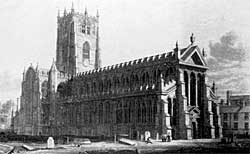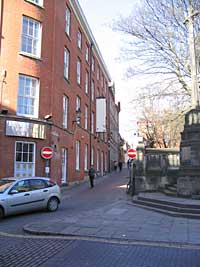< Previous | Contents | Next >

St Mary's church with its 'classical' west end (1726-1848), c.1827.
There is one use to which St. Mary's Church was put, and I cannot help wishing that it could be revived nowadays. In 1789 there was a three days' musical festival in aid of the hospital, and in 1809 another similar festival was held, at which Handel's "Te Deum," "The Messiah," and Haydn's "Creation," were performed, and £509 was raised for the hospital.
Some echo of the stirring times at the beginning of last century, when the Luddites were causing such havoc throughout the district, may be gleaned from the fact that a battalion of the West Middlesex Regiment attended service in St. Mary's Church one Sunday morning in 1812 under full arms and with fixed bayonets, for an attempted rescue of prisoners confined in the Shire Hall was momentarily expected.
The relics and the tombs in St. Mary's Church are disappointing in that they have little or no national interest. But each one of the monuments has its story to tell, and although they are mostly of the XVII., XVIII. and early XIX. century the names inscribed upon them have considerable local interest and are very well worth studying. The stone bench, made to a large extent out of tomb-stones, which runs along the north wall of the nave is an interesting feature. In olden times folk attended services either standing up or kneeling on the floor, but this was found to be extremely fatiguing for aged people and for invalids, and so a bench, such as this, was provided along the walls of the church, and sometimes surrounding the piers, and this custom gave rise to the saying, "the weakest go to the wall."
Close to the door, very faintly painted upon one of the piers, will be seen the XVIII. century inscription "Pray remember the Poor," while not very far from it, on one of the piers, is a tiny little cross which I think is probably a votive cross set up to commemorate some vow, although the usual explanation of it is that it is a consecration cross. The windows and the glass are of interest, the latter although modern being on the whole good, and the names which the windows commemorate are all of great interest to Nottingham people, while in the vestry are collected a few curios which have been discovered in various parts of the church, amongst which will be seen exceedingly fine specimens of the Lion and Unicorn which have been moved hither and thither throughout the church for many years, at one time even being placed within the Sanctuary. The use of the Royal Arms in churches is not generally understood. Although one comes across the Royal Arms before the Reformation in windows and elsewhere they are not very general, but when Henry VIII. assumed the headship of the church it gradually became the custom to place the Royal Arms in some conspicuous place in the church to signify this headship. Of course, this was all swept away during the Commonwealth, but after the Restoration, sometime during the reign of Charles II., it was made compulsory to display the Royal Arms in a church, and so emphasise both the Protestant nature of the worship and the loyalty of the worshippers.
Deering makes the very important statement that in the year 1751 a few people met on Wednesday and Sunday evenings in the vestry for the education of sixteen poor children. This must have been one of the earliest Sunday Schools, and I am rather surprised that the fact is not more generally commented upon. Sunday schools, in their origin, were not entirely religious as they are nowadays, but while being mainly concerned with religion and morals, a good deal of the attention of the teachers was occupied with what we should call elementary education. The first official Sunday School was opened by Robert Raikes at Gloucester in 1780, and the movement soon spread throughout England, and in 1784 it had reached Nottingham, when a committee was set up, subscriptions were raised and professional teachers engaged to open a Sunday School in the Exchange. The rules governing this institution are interesting, and emphasise that the children in addition to attending the school must be taken to church by the teacher and the first rule is rather amusing, reading thus: "that no children shall be received or continue unless he or she come to school with clean linen, washed hands and face and hair combed."

St Mary's gate (A Nicholson, 2004).
St. Mary's Gate, which runs by the western side of St. Mary's Churchyard, has a good deal of interest. The site now occupied by a warehouse at the junction of St. Mary's Gate and High Pavement is an extremely historical one, for on it until the middle of last century stood an old half-timbered house which was called "The Old Angel," and which represented the house of one Ralph Bugge, who was an extremely important man during the XIII. century. He accumulated a fortune by the exercise of the trade of wool-merchanting and he purchased land at Willoughby-on-the-Wolds, and settled down in that charming village, changed his name from Bugge to Willoughby. But when a coat of arms was granted to him he adopted three water "bougets" as his device, thus punning upon his name and giving us some clue as to how it was pronounced in those far-off days. He was the founder of the great family of Willoughby, whose various branches have done so much in England and in whose hands was Wollaton Hall until a year or so ago.
Sometime about 1390 lived Peter Mason, who was an alabaster carver, and was said to have lived in "St. Mary's Street," Nottingham. As far as I know there never has been a St. Mary's Street in Nottingham, and I think that probably St. Mary's Gate is what is referred to. Peter Mason was one of a great band of craftsmen who made Nottingham famous during the XIV. and XV. centuries. At Radcliffe-on-Soar and at Chellaston are quarries of alabaster, which became a very fashionable material from which to carve funeral effigies and votive tablets. The large effigies were mostly carved at Chellaston, for transport was difficult in those far-off days, but smaller objects were carved in Nottingham, and the Nottingham alabaster men became very celebrated for carving St. John's Heads and other small objects which would be used either as reredoses for altars or as panels for the enrichment of churches. It is a curious thing that our old churches in the city contain practically no specimens of their work. There are two fragments in St. Mary's Church and a portion of a tomb in the north transept, but beyond that, there is nothing, and one must go to such churches as Radcliffe-on-Soar, Willoughby, Wysall, and also to churches throughout England and even on the Continent to study the craftsmanship of this wonderful school of carvers.
